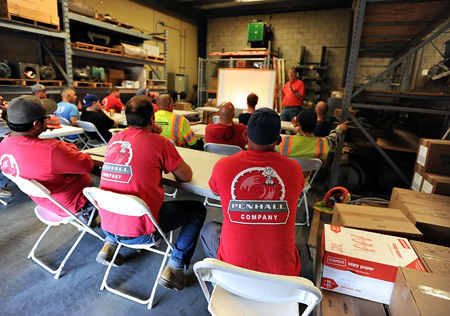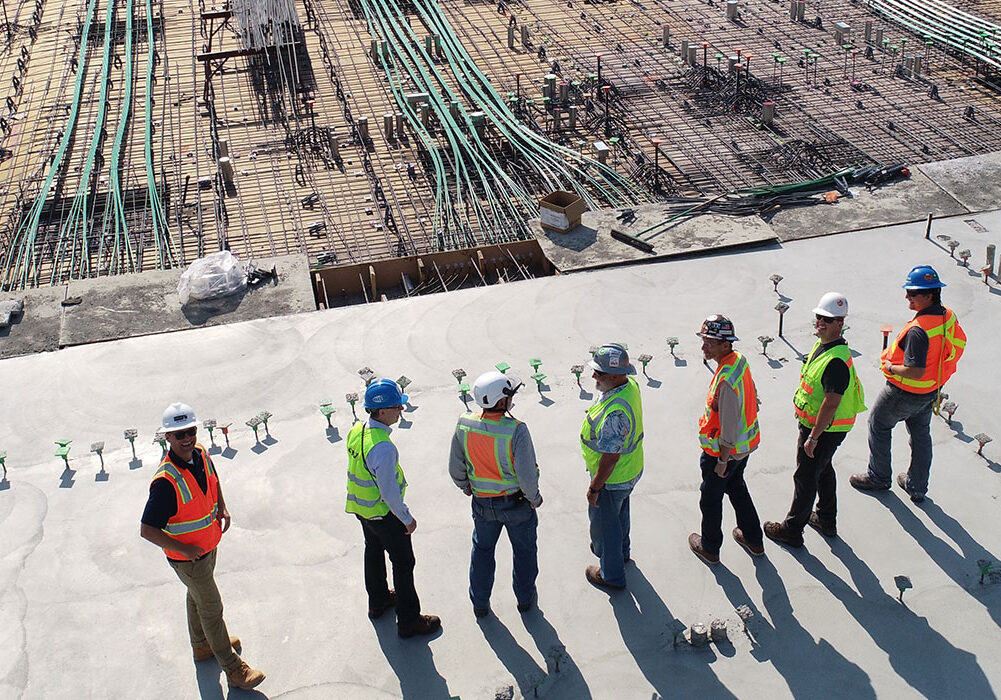By: Ray Dickinson
Have you ever heard the saying, “You learn something every day if you pay attention?” Well, that concept definitely applies to training safe operators in the field of construction.
You see, every job is different, every location is different, and every day on the job is different. Coming onto a large job can be like entering into a work tornado. Things are constantly moving and there are many things going on.
Plumbers, electricians, carpenters, foremen, crane operators, and iron workers are all buzzing around doing their own thing. What’s more is that different contracting crews usually do not communicate with one another, much less on a daily basis.
So, in order to ensure everyone’s safety, the people working on their job must learn to pay attention. This can be easier said than done, but the following steps can help prepare workers to look two steps ahead and help create a safe work environment.

New Employee Orientation
First and foremost, training safe operators starts well before they ever step foot on a job site. In addition to familiarizing a new hire to the way the company operates and the people they will be working with, employee orientation is a prime time to stress your company’s commitment to cultivating a safety culture and to ensuring an accident/incident-free workplace.A safety-focused new employee orientation should establish:
- Guidelines for communication – how to talk productively and effectively about if unsafe conditions and behaviors are recognized, etc.
- Expectations for professional conduct – interacting professionally with team members, crews on other job sites, customers, etc.
- Why a zero-injury safety culture is so important – including why it’s critical to embrace the concept that accidents are preventable.
- Safe driving techniques – learn to identify the best practices of driving behavior, and apply the Smith5Keys®.
- How to plan safety into work – Pre-Task Planning, inspecting tools, equipment, and personal protective equipment (PPE).
- How to prevent back and shoulder injuries.
- How to work safely around utilities and other energy sources.
- How to recognize hazards on the job.
- How to report on-the-job injuries and Near Miss incidents.
Safety Training
All workers should receive annual safety training. From there, depending on the degree of hazard and/or client policy, additional safety training might need to be conducted more frequently.Comprehensive, in-depth safety training should be in addition to Occupational Safety & Health Administration (OSHA) safety training. Company-specific training should include:
- Safety-focused communication skills
- How to effectively Pre-Task Plan (PTP)
- How to recognize safe and unsafe conditions and behaviors
- How to correct unsafe acts
- How to perform work safely in multiple environments
- Specialized safety procedures for job-specific tasks
- Strategies for preventing injury and illness
Initial Introduction to Field Work
By introducing new hires to field work within their first two to three weeks on the job (as both helper and laborer), they are able to experience first-hand what occurs in the field and how safety measures are built into the job.This step is also designed to help management and the other crew members evaluate how well the new hire will respect and foster a safe work environment.

Daily Pre-Task Planning By the Entire Crew
To help ensure safety in the field, each operator should be trained on Pre-Task Planning and be responsible for filling out a safety pre-task sheet before they start work each day. By auditing the job site each day on their own, the operator is better able to understand:
-
- The task that needs to be completed
- The potential hazards that could be associated with the completion of the task.
- The corrective measures that need to be put in to place to eliminate or minimize the hazard.
Typically what happens in the industry is that only one person (usually the Foreman) will conduct a Pre-Task Plan and do a “tool box” safety meeting at the start of the week. However, this process often results in hazards being overlooked – especially as the job changes and evolves.
It is critical that every crew member audits the job site each day and complete their own Pre-Task Plan.
- Active divisional safety managers. Having divisional safety managers roam the region, show up unannounced on job sites, observe the operators and ask operators at random to see their Pre-Task Plan (PTP), is a helpful tool for ensuring accountability. If the operator has their PTP and are observed conducting their work safely, they are recognized and commended. If they don’t have their Pre-Task Plan, should be written up.
- Mentorship. Training operators how to Pre-Task Plan, follow safe equipment procedures, communicate effectively, etc. are all incredibly important. But eventually, the new operator will need to learn how to apply those concepts while working independently. This is where mentorship comes in.Placing a new hire with a mentor is an invaluable part of their learning. Experienced mentors not only teach new hires how to operate equipment safely and productively, they are also there to guide the trainee in finding answers for themselves and develop solutions of their own. While on a job site, mentors can also show their trainee how to constantly look, listen, and pay attention to what is going on around them while they are in the field.
- Safety committees and monthly divisional safety meetings in the yard – Operators at each division should be part of the safety committees. Additionally, they should bring the safety-focused topics that were discussed at the monthly committee meetings to their divisional safety meeting. This helps ensure that everyone – from the executive team, to the crew on the front lines of a job – is on the same page.
Training operators to work safely in the field is not a one-time event – it’s a continuous process that everyone must be committed to each and every day.

